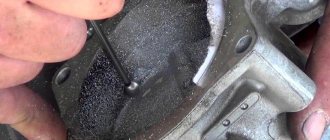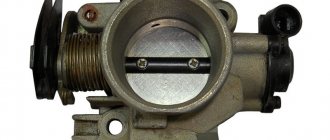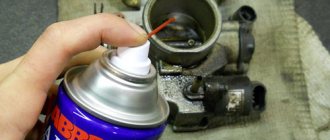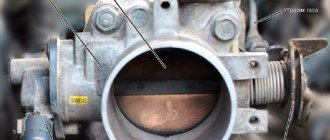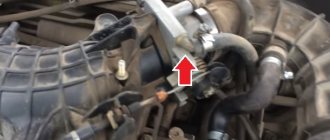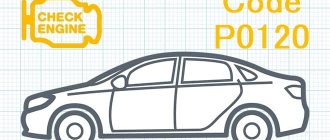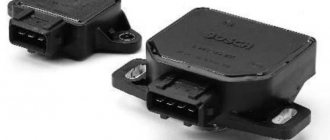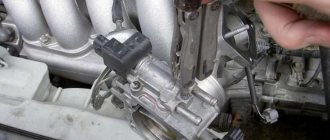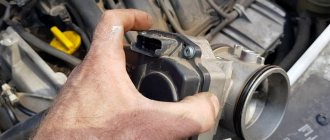March 23, 2018 Lada.Online 226 815 76
Jerking when changing gears or when starting the car. In some cases, adapting the throttle valve zero and adapting the misfire diagnostic function will help solve these problems. The adaptation process does not require special equipment and can be done with your own hands.
To remove the damper you need to perform the following operations:
- The wire is disconnected from the negative terminal of the car battery.
- The tightening that secures the ventilation hose going to the engine crankcase is loosened.
- The hose attached to the fitting of the air supply pipe is disconnected.
- The clamp connecting the pipe and the throttle becomes loose.
- The pipe is disconnected.
- The connector connecting the wires to the throttle assembly is disconnected.
- The bolts securing the throttle valve are unscrewed.
- The gasket located on the flange of the intake module is dismantled.
It should be noted that the gasket is disposable; when dismantling it, it is necessary to subsequently install a new element.
Purpose of the throttle valve
Not a single car in the world can do without such a unit as a throttle valve. The mechanism is a transverse channel regulator that changes the amount of flowing liquid or gas. That is, at its core, the damper is an air valve. When it is closed, the pressure in the intake system is equal to vacuum, and when it is open, it is compared to external atmospheric pressure.
By pressing the accelerator pedal, the degree of opening of the damper is adjusted. Accordingly, how much air enters the engine cylinders depends on this. Almost every modern car is equipped with an injection engine, where all important responsibilities are assumed by the electronic control unit (ECU).
As some car enthusiasts know, the optimal ratio of gasoline to air is 1:14.7. By detecting the throttle position and the amount of air using sensors, the ECU regulates the operation of the injectors and fuel pump. This knowledge will be useful in deciding how to adapt the throttle valve.
In other words, the computer commands how much fuel needs to be supplied to the engine in order to maintain optimal proportions.
A few words about the car and the intake system
Since we are interested in the Priora throttle valve, we simply need to understand the engine structure of this particular model in order to find out where this part is actually located, why it needs to be cleaned and what damage can be caused by untimely maintenance. Lada Priora has been produced since 2007 in sedan, hatchback and station wagon versions.
The car went through several restylings, its appearance changed slightly, but the level of comfort, safety and quality of the Priora car noticeably improved. Today, models with automatic transmission are even available.
But no changes were made to the configuration of the equipped engines; the car is equipped with almost identical 4-cylinder engines with varying differences in the power offered: from 81 to 120 horsepower. All Prior engines are injection engines, the main difference from carburetor engines is the forced supply of fuel at certain moments directly into the engine cylinder. Our desired throttle valve also plays a significant role in this system. It migrated to the injection system from the carburetor, and, in principle, performs the same role - it meters the amount of air entering the intake manifold.
Throttle valve on Priora
On the Lada Priora engine, the valve itself is located in the throttle assembly, which in turn is located on the intake manifold. The unit is connected to the accelerator pedal drive, by pressing which the driver changes the position of the damper. The electronic intake system is a precise system for which it is necessary to take readings from certain sensors (mass air flow sensor, camshaft position sensor, crankshaft position sensor and many others). There are many of them, but we are concerned with the one that is directly related to the throttle valve. Correctly called a throttle position sensor (the abbreviation TPS is usually used), it monitors the position of the throttle and transmits data to the on-board computer so that all other elements of the power system work harmoniously.
The remote control position sensor can be either electrical or mechanical, which depends on the price of the car, although the difference between them is small.
The position sensor can also break, and when cleaning the throttle assembly, it would be useful to check it. If it becomes noticeable that the car does not switch well from high speeds to low speeds, the engine does not start well in cold weather, at low speeds the engine stalls or runs poorly - this could all be due to contamination of the throttle valve.
This is interesting: What is CVT on Toyota
When and how to do it yourself
When to do it
adaptation of the throttle valve zero and adaptation of the misfire diagnostic function:
- After replacing the ECU controller or resetting the controller using a scan tool.
- After replacing the throttle assembly.
Throttle zero adaptation procedure
:
- When the car is stationary, you must turn on the ignition, wait 30 seconds, turn off the ignition, wait until the main relay turns off.
Adaptation will be interrupted
, If:
- the engine turns over;
- the car is moving;
- the accelerator pedal is pressed;
- engine temperature is below 5 °C or above 100 °C;
- Ambient temperature is below 5 °C.
Adaptation procedure
Misfire diagnostic functions:
- warm up the engine to operating temperature (parameter value “Coolant temperature” = 60.90 °C);
- accelerate the car in 2nd gear until higher crankshaft speeds are reached (parameter value “Engine crankshaft speed” = 4000 min-1) and perform engine braking (“Engine crankshaft speed” = 1000 min-1);
- Perform engine braking six times in one trip.
FakeHeader
Comments 23
Pedal adaptation helps me personally! When I came for diagnostics, about six months after purchasing the car, the diagnostics showed that the gas pedal was not adapted! I performed the above operation on rpm from 1000 to 4000 and it adapted! These failures, if you suddenly give the gas to the floor even for a second, are annoying! After chipping there was not a single failure at all, you press sharply and it immediately slips without delay! For some reason, about a month later, a small failure appeared again!
This is not an adaptation! What you described is enabling the misfire diagnostic function.
Throttle valve adaptation is done as follows:
1. Ignition on 2. Wait 30-40 seconds. 3. Start the internal combustion engine. 4. Turn off the ignition 5. Wait for the main relay to turn off. 6. Everything
But only then we go to the track and adapt the passes.
But before this, you need to warm up the internal combustion engine until the fan turns on three times.
initialization, and then the above written by the author! Helps! ) BC State1 for help or diagnostics
The staff transfers to 95th without training, many ride on 92nd
You read more carefully (— adaptation of the throttle position zero. For this, the first turn on of the ignition switch after replacing the controller) after replacing the controller. Removing the terminal from the battery or resetting the settings by the staff does not affect anything. Again, we carefully read (adaptation of the misfire diagnostic function of the controller in order to avoid damage to the catalytic manifold and possible fire of the car) misfires have nothing to do with the pedal in general. In the first case, all this is done at the factory. This is only necessary when the brain changes or the throttle assembly.
or by “resetting” it with initialization using diagnostic equipment, my B.K can do initialization, so for whom how
If the staff resets it, won’t it work?
I think no! The state only resets the values to zero! This is different!
I’ll try this during the day, otherwise I’ve already sinned on the filter, you press the pedal, from 2 to 3 there are dips, that is, no!
try! Let me know if it helped or not!
I need to try it, otherwise there are holes in my guts
everything is clear, I just changed the firmware, I did it! But when I drove around after buying the car for about six months and stopped by for diagnostics! It revealed that for some reason the pedal was not adjusted! And even after the firmware, the car was tearing out from under itself, and about two weeks ago small gaps appeared again! I tried from 1000 to 4000 as it was written to do everything, the pedal became more responsive! But it’s still not the same as right after the firmware!
Throttle learning not at idle - what is this process?
When the throttle assembly of any modern vehicle operates, a lot of contaminants in the form of dust, soot, and oil gradually accumulate on the surface of the throttle. They form a layer of dirt, which makes the air gap between the damper and the car's air duct smaller than the established norm. This gap is important for the normal functioning of the “heart” of the car, since thanks to it the idle speed is maintained at the required level.
When it decreases, the vehicle's electronic control unit (car computer) slightly opens the damper by introducing coefficients that take into account changes in its cross-section. Up to a certain point, the ECU manages to maintain the air gap at a constant level, but sooner or later the throttle valve will still have to be cleaned of dirt. After flushing this unit, the engine speed will certainly increase due to the fact that the cross-section of the throttle, freed from the contaminant layer, will become larger.
The procedure for returning to the initial (set by the manufacturer) position of the damper is usually called training or adaptation.
Mechanical throttle
Currently, a mechanically driven damper can only be found in budget car configurations. In such a mechanism, the damper is connected to the accelerator pedal via a metal cable, fixed to the shaft and placed in a housing on which sensors are also located:
- idle air controller (IAC)>;
- throttle position (TPP).
All this looks like a separate block. Various pipes also lead to it; coolant is supplied and discharged through one, and through others the crankcase is ventilated and fuel vapors are captured.
Thanks to the IAC, the required number of crankshaft revolutions is maintained when the damper is closed. The regulator itself consists of a stepper motor and a special valve. Together they regulate the amount of air, regardless of what position the throttle valve is in. Usually there are no problems regarding how to adapt the throttle valve in the case of a mechanical drive.
Code P0122 Low signal level of the Lada Vesta throttle position sensor.
Code P0122 is entered if:
- ignition on;
- the throttle position sensor signal voltage (ADC parameter “ Throttle sensor voltage 1 ”) is less than 0.25 V for 0.12 s.
The malfunction indicator lights up 5 s after the fault code appears.
Description of checks.
The sequence corresponds to the numbers on the card.
- Using a diagnostic tool, it is checked whether code P0122 is active at the time of diagnosis. If only code P0122 is detected, then the fault must be looked for in the signal circuit of TPS A. If codes P0122 and P0222 are detected at the same time, then the fault must be looked for in the power circuit of TPS A and TPS B.
- The circuit is checked from contact “X1.2/G2” of the controller to contact “3” of the electronic protection device.
- The controller is checked: when you bridge contacts “3” and “5” of the block to the EDS using a probe, the TPS A signal on the diagnostic device should change.
- The circuit is checked from contact “X1.2/E3” of the controller to contact “5” of the electronic protection device.
- The controller is checked: pin “5” of the block to the EDS should receive a reference voltage of 5 V from the controller.
Signs of throttle adaptation
The throttle valve in its modern form is one of the last components to undergo electronic modernization. Instead of mechanical rods, a compact electric motor is installed on it, which serves as an actuator.
The signal to it comes directly from the throttle sensor. Together, this system allows you to control the engine correctly, supplying the required volume of fuel mixture to the combustion chambers in a timely manner. There are several signs by which you should start adjusting the throttle position.
For example, when you suddenly release the gas pedal, the engine does not go to idle and stalls; the following can also happen:
- Unstable engine operation at idle;
- a significant “freezing” of revolutions around the 1.5 thousand mark;
- drops in speed when gaining power;
- the “CHECK ENGINE” indicator lights up on the dashboard;
- difficult start at ;
- lack of response when pressing the gas pedal.
Depending on the engine type, there may be a slight loss of power, for example with engines with a V8 configuration. Also, fuel consumption almost always increases. These signs appear especially often on cars with a mileage of 30 thousand km or more, equipped with turbocharging.
– dancing with a tambourine, battery and ignition
Warm up the engine to operating temperature. Usually 80-90 degrees is enough and we turn off the engine.
Disconnect the battery, remove the terminal from it
. This is necessary to reset the parameters in the control unit. In a simple way - reset the ECU to factory settings. This will allow the unit to retransmit the damper values in the closed position.
To calibrate the throttle you need to remove the battery terminal
To calibrate the throttle you need to remove the battery terminal
We wait five minutes
. This is enough for the control unit to be completely de-energized. We connect the terminal to the battery. Don't forget to tighten it to make better contact.
Turn on the ignition and wait 30-40 seconds
without touching or pressing anything. At this time, you may hear a buzzing noise under the hood. This adapts the throttle, the motor moves the damper, determining its position and recording this data in the ECU. This is typical only for electrical and electromechanical remote sensing devices.
Turn off the ignition and wait 15 seconds
. After this time, we turn on the ignition, wait until all the indicators on the dashboard go out and start the car. We check the engine at idle speed, the speed should be normal.
In most cases, this method of adapting the throttle valve gives positive results.
It may not work on cars: Audi with a 1.8 liter ADR engine, Opel Corsa, Octavia Tour 1.6 akl engine, 4th generation Golf, Audi A4 ADL B5 body. All cars have non-volatile memory, which cannot be reset by removing the terminal from the battery.
Torque
To change the amount of torque, the electronic control unit can change one or more parameters:
- throttle opening angle
- boost pressure (if the engine is turbocharged)
- ignition timing
- fuel injection timing
- turning on/off cylinders
The amount of torque is constantly adjusted and depends on the following factors:
- engine starting conditions
- stable idle speed
- O2 content in exhaust gases
- restrictions on power and number of revolutions
- Automatic transmission (when shifting gears)
- traction control when braking
- forced idle when braking
- equipment operation (climate control, air conditioning)
- cruise control (whether the mode is on)
The car jerks in first gear or second speed: fault diagnosis
As mentioned above, in such a situation, the first step is to gradually eliminate problems in the power supply system, ignition, as well as failures in the ECM. For example, a common reason when the car jerks at low speeds when engaging first and/or second gear is insufficient fuel/air supply to the engine or impaired mixture formation.
Various ECM sensors (Hall sensor, TPS, mass air flow sensor, etc.) can also malfunction. If everything is fine with the sensors, then you need to check the engine ECU. Quite often, the problem of jerking in 1st-2nd gear is directly related to the ignition. It is necessary to check the condition of the spark plugs and high-voltage wires, distributor and other elements on a particular machine.
As a rule, if the car drives jerkily, in relation to injection cars, specialists conduct comprehensive computer diagnostics of the engine. If such a check does not produce results or the cause is not found, then the vehicle’s transmission deserves special attention.
So, if your car is noticeably jerky in 1st and/or 2nd gear, it is important to understand that the transmission may also be causing the car to jerk when driving. At the same time, it is easier to determine the cause in the case of a manual transmission, while various types of automatic transmissions require more serious checks
Let's start with the manual transmission.
Please note that if an inexperienced driver's car jerks in first gear when starting off, it should be borne in mind that often beginners simply make mistakes when releasing the clutch, while the car itself is working properly
To start without jerking, you need to smoothly release the clutch before the driver feels the grip point (the beginning of the transmission of torque from the engine to the wheels). After the force begins to be transmitted to the wheels and the car begins to move, you need to carefully add gas, dosing the traction with the pedal accelerator.
But jerking is usually caused by problems with the clutch on the manual transmission or its adjustments. For example, a car jerks in first and second when the clutch driven disc is badly worn, the clutch does not “close” completely, and slips. This leads to the car jerking when changing gears.
In this case, jerks most often appear precisely in “low” gears (first, second speed), when the smoothest possible operation of the clutch is needed and at the same time, through the clutch in these gears, a sufficiently large torque is transmitted from the internal combustion engine to the gearbox when accelerating the car.
Now let's move on to automatic transmissions. First of all, you need to take into account that the quality of operation and smoothness of automatic transmission shifts will depend on the type of automatic transmission.
First of all, jerking can occur when driving with robotic gearboxes that have both one and two clutches. The fact is that the clutch of such gearboxes resembles in its design and principle of operation a conventional friction clutch of a manual transmission. Often the solution to the problem is to replace the DSG or AMT clutch, after which it is imperative to adapt the clutch (training, setting the grip point).
Also, in some cases, the culprit that the car jerks when driving in 1-2 gears may be breakdowns and malfunctions in the actuators that are responsible for the operation of the clutch in automated mode.
It should also be noted that the automatic transmission itself can “slip”, and the quality of its operation greatly depends on the level/condition of the transmission oil (ATF fluid). Jerking in automatic transmissions of this type may occur due to insufficient or overfilled oil, the use of a lubricant with unsuitable properties, etc.
Jerking in a car with an automatic transmission in certain gears (especially during shifts) may indicate problems with the brake band, valve body, automatic transmission solenoids, sensors, separate automatic transmission ECU, etc.
Taking into account the above, we can conclude that the machine needs to be checked comprehensively, paying special attention to the level of lubrication and the quality of the oil itself
Features of the Lada Granta throttle assembly
The throttle valve is turned by an electric motor through a gearbox. Both are built into the throttle body. When starting and warming up the engine, as well as during idling, the flow of air into the cylinders is regulated by opening the throttle valve. The throttle position is controlled by two sensors built into the throttle body.
The throttle valve opening angle is set by the electronic control unit (ECU) depending on the estimated amount of air that should enter the engine cylinders. This takes into account the operating mode of the engine (starting, warming up, idling, and so on), the temperature of the ambient air and the engine, and the position of the gas pedal.
Control commands are sent to the throttle assembly to the electric motor. At the same time, the ECU monitors the opening angle of the damper and, if necessary, sends appropriate commands to adjust its position. As a result of the fact that the ECU simultaneously regulates the amount of injected fuel and incoming air, the optimal composition of the combustible mixture is maintained in any engine operating mode.
The electric throttle body is sensitive to deposits that may accumulate on its inner surface. The resulting layer of deposits can interfere with the smooth movement of the throttle valve, jamming it (especially at low opening angles). As a result, the engine will operate unstably and even stall at idle, start poorly, and failures may also appear during transient conditions. To avoid this, as a preventive measure, deposits should be removed with special detergent compounds during regular vehicle maintenance. A large layer of deposits can completely block the movement of the damper. If flushing fails to restore the throttle assembly to operability, it must be replaced.
A malfunction or incorrect operation of the throttle assembly may be caused by a broken contact in its electrical circuit (oxidized terminals in the wiring harness connection block). In this case, it will be possible to restore operation by treating the terminals with a special compound for cleaning and protecting electrical contacts. There are other possible causes of the malfunction:
— no supply voltage is supplied to the throttle assembly;
— signals are not received from both throttle position sensors;
— The computer cannot recognize signals from the throttle position sensors.
In these cases, the engine control system goes into emergency mode. At the same time, the car retains the ability to independently move a short distance at a slow speed, which, in extreme cases, will allow it to be moved to a safe place
The fact that the throttle assembly is operating in emergency mode may be indicated by a burning indicator lamp for a malfunction of the engine management system and an increased speed of the crankshaft at idle (about 1500 min-1, despite the fact that the engine is warmed up to operating temperature), the engine at this will not respond to pressing the gas pedal.
Each of the throttle position sensors is a potentiometer. During operation, gradual wear of conductive paths and moving contacts occurs. Over time, wear can reach such an extent that the sensor cannot function correctly. The presence of two sensors increases the reliability of the entire unit.
If only one sensor fails, the warning lamp will light up, but the engine management system will switch to backup mode. In this case, the engine will respond adequately to pressing the gas pedal, but with worse performance parameters
The reserve mode allows you to drive your car to the repair site under your own power.
Adjustment
The adjustment process may vary on different car models, since different manufacturers use mechanisms of different designs. But the same principle can be applied for configuration. As for a specific model, it is better to find information on it in advance.
- Features of the operation of gas equipment of the 1st generation - the “old man” in the world of gas installations
To begin the adjustment, the first step is to remove the pedal from the holding bracket. Next, loosen the screws securing the cover. One screw holds the cover in a certain position - it must be completely unscrewed. The cover is turned to the side clockwise until the end, then the screws are tightened again.
This is interesting: How to make a foam generator for a car wash with your own hands
This adjustment will reduce pedal response time. Some car owners note that after such adjustments, the response speed can even be compared with a mechanical pedal. Adjustment allows you to improve engine performance and improve the start of movement from a standstill.
In cases where a pedal with low sensitivity is needed, it is necessary to rotate the cover in the opposite direction - counterclockwise. The machine begins to respond to presses not so quickly.
Sometimes you can come across harmful adjustment tips - drivers advise placing shims under the lever. This is the wrong approach. Sometimes the pads get caught under the contact pads in the potentiometer, and the machine may lose control as a result.
Conditions for carrying out the idle speed adaptation process
Before starting training, a number of prerequisites must be met:
- travel by car for 10 minutes;
- ensure that the battery voltage at idle is at least 12.9 V;
- warm up the gearbox;
- The wheels of the vehicle must be straight, the steering wheel must be in the middle position;
- engine temperature – 70–95 °C;
- all devices that put a load on the car’s electrical network (heated windows, headlights, etc.) should be turned off;
- The automatic transmission selector is set to N or P.
Causes
The most common reason for an adaptation to be made is the consequences of throttle valve maintenance. As a result of operation, a large amount of deposits forms in this unit, therefore, after flushing, the position of the throttle valve changes, and the ECU continues to send signals about its condition until maintenance.
Over time, natural wear occurs on the resistive layer of the sensor potentiometer and the moving elements of the throttle valve; in this case, after adaptation, it will most often require replacement. It is necessary to conduct training if changes are made to the ECU settings (chip tuning), especially if operations have been performed to increase engine power.
The procedure is performed using special programs on computer equipment or without them (a strictly defined procedure, which will be discussed below) depending on the brand of car. Auto electricians must take into account the features of the model, year of manufacture, and type of ECU installed on the vehicle.
Why does the car jerk when driving at low speeds?
If the defect is noted when the vehicle is driven at low engine speeds, the reasons can also vary greatly. More often we are talking about failures of the fuel supply system, but the breakdown may lie in other components.
Supply system
This unit most often suffers when the wrong air-fuel mixture is supplied. If the car jerks when driving at low speeds, you will need to check the following:
- Condition of the throttle body: there may be cracks in it.
- Serviceability of idle speed sensors.
- Tightness and cleanliness of injectors.
- Condition of air ducts, percentage of wear.
If the diagnostic steps reveal that there are problems with these parts, it is recommended to immediately install new parts. After servicing, it is necessary to check the quality of connections, tightness, and pressure level in the fuel unit.
Ignition system
The malfunction may lie in premature ignition of the air-fuel mixture, or less often we are talking about low voltage on the spark plug elements. During diagnostics, the following is checked:
- Serviceability of the ignition coil.
- Condition of the candle set.
- No mechanical defects in wiring.
- Distributor functionality.
- The camshaft and crankshaft sensors are correct.
- Switch health.
Often twitching is caused by installing candles of the wrong size or by violating the installation technology. Replacement will help get rid of the unpleasant phenomenon.
Transmission
If the owner performs gearbox maintenance too rarely and does not observe the lubricant change interval, the car begins to twitch when driving at low speeds. The malfunction is especially typical for cars with automatic transmission and robotic gearbox. With a total mileage exceeding 150–200 thousand, noticeable jerks often appear. As a result, the oil in the gearbox begins to foam, the solution becomes thicker or, on the contrary, thinner. It is better to restore the gearbox at a service center; it takes an average of 3–4 hours. It’s better not to carry out the work yourself: you don’t always have the right tool at hand, and besides, this task is not an easy one, especially if the box has an automatic design.
Accelerator
When a driver quickly presses on the gas, the number of revolutions of the power unit immediately increases, which can cause a decrease in the efficiency of the vacuum regulators. After this, if the engine starts to operate at low speeds, its distributor falls, and the vehicle moves jerkily. With continuous combustion of fuel, the driver strives to increase the speed of the internal combustion engine; this cannot be done quickly if the regulators malfunction or fail completely. As a result, if the oxygen flow is not supplied synchronously and the damper is opened, the fuel does not burn immediately, which can damage the advance angle bearing.
During repairs, the regulators are first diagnosed: the hoses with pipes are removed, covering them manually. If there is no vacuum during engine operation, the reason is a damaged throttle valve. The part should be replaced, and then the car should be tested.
Self-cleansing procedure
If the damper is electronically actuated, then it is better to remove the negative terminal of the battery. Next, you can do everything according to simple instructions:
- dismantle the air filter by unscrewing the pipe clamp;
- disconnect all connectors of the throttle module and other pipes;
- move the air filter receiver to the side so that it does not interfere, and begin cleaning the damper;
- upon completion, reassemble the damper module in reverse order, checking that everything is in place;
- After assembly, start the engine and check the idle speed.
In some cases, before you begin to adapt the throttle valve on a Toyota, Nissan or Skoda, it is necessary to remove the throttle itself, which allows you to completely clean the valve. To do this, you will need a 5 mm hexagon to unscrew the 4 fasteners. Removing the throttle should be done with great care, as there is a risk of damaging the gasket.
If, after cleaning the throttle body, increased idle speed is observed, it means that the damper needs to be adapted.
Tags
throttle valve.throttle valve essence the valve is the opening of the valve.throttle valve and the throttle valve.throttle valve time the valve laughs in the mechanism the valve is connected to the position of the valve is maintained is the throttle valve adapt the throttle valve.Purpose of the throttle valve throttle position hold adaptation of the damper. The need for adaptation of remote control adaptation. Adaptation involves adaptation without the peculiarities of adaptation and Cars
malfunctionsinstallationladatuninggaladegroupvasaz
Throttle learning idle
After flushing the unit or reflashing the ECU, the throttle valve should be trained to idle. To do this, fulfill the following conditions:
- check the voltage on the battery with the engine off, it should be at least 12.9 V;
- the coolant temperature should be in the range from 70 to 100 degrees;
- the steering wheel must be in a neutral position;
- The gearbox oil must be warmed up;
- all electrical consumers are turned off;
- automatic transmission handle in position P.
Failure to comply with the above requirements will lead to incorrect operation of the engine, so they must be followed. After warming up the engine, you must:
- turn off the ignition for 10 seconds;
- make sure that the accelerator pedal is in the up position;
- turn the key to the ON position for 3 seconds (do not start the engine);
- Press the gas pedal all the way 5 times within 5 seconds and release it for the last time;
- after 7 seconds, press the gas pedal all the way and wait until the “CHESK ENGINE” display lights up continuously;
- After pausing for 3 seconds, release the gas pedal.
Try to start the car, the attempt can be repeated several times. During stable operation, rev the throttle several times and the idle speed should return to the acceptable range.
The procedure for learning the throttle using a PC and car programs has its own specifics, depending on the brand of car, etc. Therefore, it makes no sense to describe the entire process in detail. But first you need to install special software on your PC, for example, VAG-COM for a VAG car group (or other) and drivers. The following is the standard connection order for all:
- turning on the ignition;
- connecting the PC to the car diagnostic connector with an information wire;
- launching software on a PC;
- conducting a test;
- receiving information about readiness for further work - the inscription: “The adapter is ready for work.”
Following a special algorithm, you will be able to coordinate the remote control and the ECU in the “throttle fully open/fully closed” modes for cars with both an electronic and mechanical gas pedal. In this case, the throttle valve training is carried out when the car is warm and the above requirements are met.
- Features of the Lada Granta throttle assembly
- Electronic gas pedal Lada Granta
- Malfunctions of the electronic gas pedal
- Cleaning the electronic throttle valve E-Gas Lada Granta 16V
Via phone
Instructions:
- For an Android smartphone, download and install the ECU Tweaker application. We copy the ecu.zip archive to the root of the internal or external memory without unpacking it.
- Connect the ELM327 V1.5 adapter to the OBDII port of the car.
- Turn on the ignition.
- Launch the “ECU Tweaker” application on your smartphone
- In the search, select “BM LADA”
- Then "Automatic Transmission"
- Then "BVR_On_CAN_x52_JS3_v2.4"
- Then "After sales"
- Then "Diagnostic"
- Then the "Wrench" button
- Go back and select “Learnings information”
- Go back and select “Learnings Procedures”
- Complete the training (see “Training Procedure” above)
Need for maintenance
The prophylaxis procedure should not be carried out in the absence of obvious reasons. Before starting, you need to carefully evaluate the condition of the throttle valve. If there are no obvious signs of tar deposits and areas of coking, then the reason for unstable operation may lie elsewhere.
Also consider the mileage of the car. Experts recommend resorting to flushing no earlier than after 100 thousand km. But on some cars, for example, a Ford Focus, it may be necessary to flush it after 30 thousand kilometers.
You should know how to clean your throttle body to achieve the desired result. This requires a special carburetor cleaning solution, for example, Abro Carb & Choke Cleaner or similar products. The assembly must be dismantled; only in this case can the maximum effect be achieved, otherwise carbon deposits will remain inside the tubes. Disconnect all pipes from the throttle valve to gain good access to the inlet part of the assembly.
Remove carbon deposits delicately using a clean rag or soft brush. Do not use excessive force; you may damage the valve. The internal elements are coated with a thin layer of molybdenum, which novice car enthusiasts mistake for harmful deposits.
The consequences of zealous cleaning can be different: the moving part of the damper will begin to bite, or vice versa, in the closed position it will begin to let air through. In this case, it will not be possible to do without repairing the throttle valve.
Gas pedal with mechanical throttle control
In the mechanical throttle control drive, a cable is attached to the gas pedal, which goes directly from the passenger compartment to the engine compartment and the other end is screwed to the throttle control drive (a semicircular iron part next to the throttle). When you press the pedal, the cable stretches and pulls this part, which is directly connected to the throttle valve and is usually located on the same axis of rotation with it. The damper slightly opens or closes the pipeline through which air is supplied to the engine. The rest is done by electronics. To achieve the desired torque, the electronic unit changes the ignition timing and the timing of fuel injection into the combustion chamber. This regulates the fuel-air mixture and achieves the required torque.
Electromagnetic throttle valve
The electronic analog, unlike a mechanical unit, allows you to achieve the optimal torque value in any engine operating mode. The level of fuel consumption is reduced, and driving such a car is comfortable and safe. The main distinctive features (and in this case, advantages) are the following:
- idle speed is controlled by moving the throttle valve;
- there is no mechanical connection between the pedal and the damper.
Due to the fact that there is no mechanical connection, torque can be controlled electronically instead of the gas pedal. The damper module itself consists of the following elements:
- housings;
- the damper itself;
- electric drive;
- return spring mechanism;
- damper position sensors.
Installing not one, but two damper position sensors in the module will improve reliability. For this purpose, magnetoresistive devices or potentiometers with sliding contacts can be used. It is precisely because of the breakdown of these elements that it is necessary to decide how to adapt the throttle valve on many cars.
If a malfunction occurs in the electric drive, the damper is brought to the emergency position due to the return spring mechanism. In this case, the module itself must be replaced, which can only be done as an assembly.
conclusions
The main cause of failures are spark plugs, but they are not the only ones that influence the appearance of this effect. Some car enthusiasts may not be able to cope with the occurrence of such malfunctions on their own, and it is necessary to go to a car service center, where they will carry out high-quality diagnostics and also fix the problem. But it is worth considering that you will have to be generous, since neither computer diagnostics nor repairs will cost a penny.
The brakes, of course, were invented by cowards - any reckless driver will tell you that. But when you realize that there is “something wrong” with them, it becomes scary to get behind the wheel: the trip may be your last. We drive thoughts like “it will do” away: the jokes are over
It is important to determine the type of malfunction - at least in advance
Electronic gas pedal Lada Granta
On modern cars, instead of the usual cable drive for throttle control, a so-called “electronic gas pedal” is installed. In such cars, the throttle position is controlled electronically. When you press or release the gas pedal, information about this goes to the control unit (ECU) and only after processing and adjustment is a command given to the throttle module. The pros and cons of such a system, as well as signs of malfunctions, will be discussed in this article.
For those who are accustomed to mechanical drives, where pressing the gas pedal directly causes the throttle to move, driving a car with an electronic system will be unusual and unknown. To understand, you need to understand the principle of operation of the “electronic pedal” and its difference from a conventional mechanical one.
Feedback on the E-Gas modification
Car enthusiasts who have already completed the adjustment note that if you move the pedal assembly cover clockwise, the car becomes a little more lively. If you press the pedal as before and the car starts to move, you have to get used to it and not press the gas so hard. When you press the pedal to the floor, you can't feel the difference.
Those who adjusted the E-gas for a quieter ride noticed that driving on the highway became more comfortable. Now, to maintain speed, you need to press the gas pedal a little harder, which allows your leg to not be as tense as before.
Other motorists do not believe in the positive effect, saying that it is all self-hypnosis. The operation of the electronic gas pedal is based on changing the resistance difference. And even if you move the cover, when the engine starts, the ECU will still consider it to be zero and adjust the throttle from this point. And if you increase the sector stroke, the E-gas error “signal outside the permissible limits!” will appear.
Have you encountered such modification of E-gas? What feedback can you leave about such adjustments? Is there a positive effect or is it all at the level of self-hypnosis? Let us remind you that if necessary, you can check the E-gas yourself. By the way, an alternative to modifying the electronic gas pedal is chip tuning.
When is the damper adaptation performed?
The need for such an operation, which involves bringing high idle speeds to a standard value, arises not only after flushing the throttle assembly, but also in other cases, in particular in the following:
- after the vehicle battery is completely discharged;
- after replacing or removing the accelerator pedal;
- after replacing or reconnecting the vehicle's electronic control unit.
Undoubted signs indicating that the damper needs to be trained immediately are the following phenomena:
- whistling when revving;
- inadequate behavior of the engine at idle;
- lack of power at idle or failures.
Why does a Nissan engine consume oil?
The family includes engines ranging from 1.3 to 1.8 liters. And in fairness, we note that all of them are “lovers” of eating butter. I wonder if we will find signs of oil in our unit?
The fact is that restyled engines released in 2003 showed a special “oil appetite”. At the height of the problem, cunning engineers and servicemen released information that oil consumption of up to 500 grams per 1000 km is not a warranty case. If the engine began to consume more, it was replaced under warranty. True, even on the new engine, the problem of oil consumption began to appear already after a mileage of 15,000 km.
Decoking, replacing the membrane (breather) of the crankcase ventilation system, replacing or cutting out the catalyst do not in any way affect the oil consumption of QG series engines.
In general, the QG18DE motor is not anything special structurally, and therefore it is difficult to expect much trouble from it. However, some features of this engine entail large investments in repairs.
Throttle valve clogged and cleaning intervals
From time to time, the throttle valve inevitably becomes clogged, which manifests itself in various ways. In this regard, a reasonable question arises: how often should it be cleaned? It is not entirely possible to answer this unequivocally, since there are no recommendations on this matter. Some car owners visit auto repair shops when they suspect an engine problem.
Some people believe that the damper needs to be cleaned after every 40,000-50,000 km. Others have a different opinion and clean the damper more often, after 30,000-40,000 km.
Typically, black carbon deposits on the valve indicate low quality fuel. When operating a vehicle with such gasoline, there is a risk of oily deposits forming. After this, there should be no question whether the throttle needs to be adapted.
As a rule, if the piston group is experiencing some problems, then a characteristic sign is the valve becoming coked with soot and oily impurities. Sometimes this indicates crankcase ventilation is clogged.
Sources
- https://la-granta.ru/kak-snjat-drosselnyj-uzel-na-avtomob.html
- https://FB.ru/article/337282/kak-adaptirovat-drosselnuyu-zaslonku-polnaya-instruktsiya
- https://automotocity.com/avtovaz/kak-obuchit-drosselnuju-zaslonku-na-lada-granta.html
- https://tuningkod.ru/chip-tuning/drosselnaya-zaslonka/obuchenie-drosselnoj-zaslonki.html
- https://o-ladagranta.ru/adaptacija-drosselnoj-zaslonki-granta-16-klapanov/
- https://www.spike.su/index.php/%D0%94%D1%80%D0%BE%D1%81%D1%81%D0%B5%D0%BB%D1%8C%D0%BD %D1%8B%D0%B9-%D1%83%D0%B7%D0%B5%D0%BB-%D0%9B%D0%B0%D0%B4%D0%B0-%D0%93%D1% 80%D0%B0%D0%BD%D1%82%D0%B0.html

